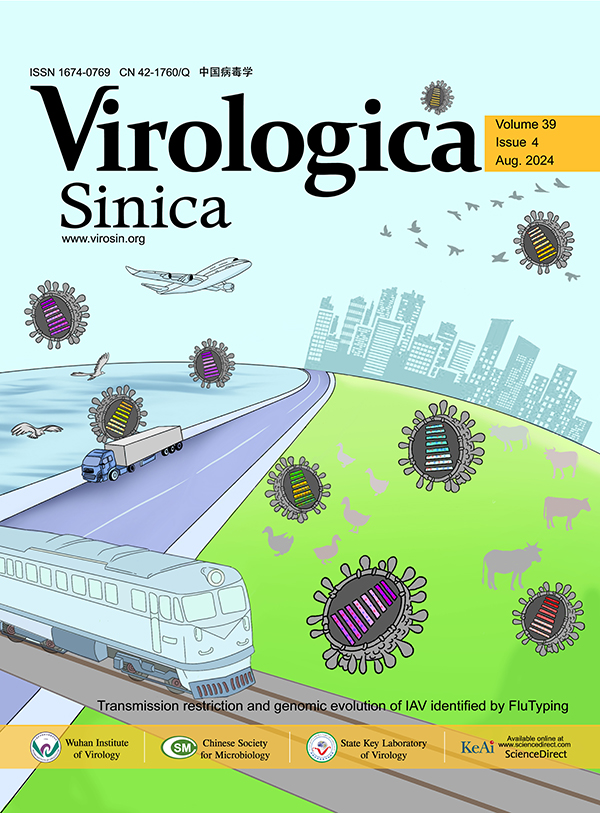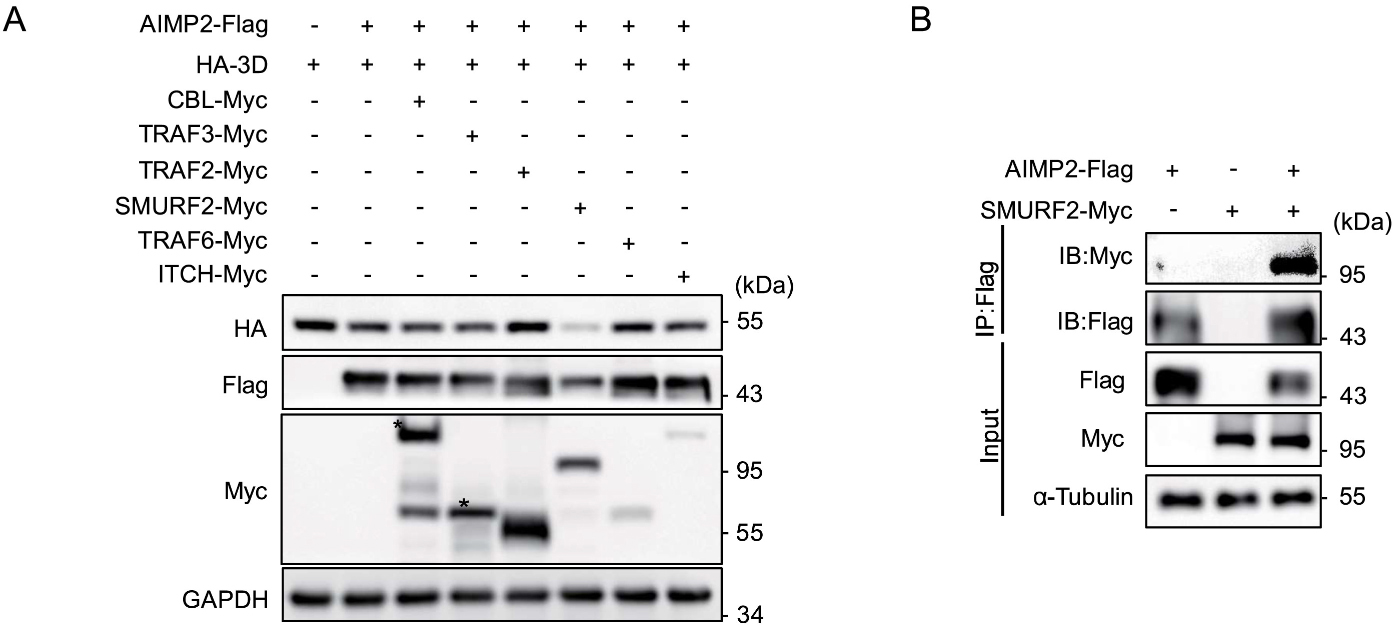-
Ang, P.Y., Chong, C.W.H., Alonso, S., 2021. Viral determinants that drive Enterovirus-A71 fitness and virulence. Emerg. Microbes Infect. 10, 713-724.
-
Baer, A., Kehn-Hall, K., 2014. Viral concentration determination through plaque assays: using traditional and novel overlay systems. J. Vis. Exp., e52065.
-
Baggen, J., Thibaut, H.J., Strating, J., van Kuppeveld, F.J.M., 2018. The life cycle of non-polio enteroviruses and how to target it. Nat. Rev. Microbiol. 16, 368-381.
-
Chen, S.C., Chang, L.Y., Wang, Y.W., Chen, Y.C., Weng, K.F., Shih, S.R., Shih, H.M., 2011. Sumoylation-promoted enterovirus 71 3C degradation correlates with a reduction in viral replication and cell apoptosis. J. Biol. Chem. 286, 31373-31384.
-
Choi, J.W., Kim, D.G., Park, M.C., Um, J.Y., Han, J.M., Park, S.G., Choi, E.C., Kim, S., 2009a. AIMP2 promotes TNFalpha-dependent apoptosis via ubiquitin-mediated degradation of TRAF2. J. Cell Sci. 122, 2710-2715.
-
Choi, J.W., Um, J.Y., Kundu, J.K., Surh, Y.J., Kim, S., 2009b. Multidirectional tumor-suppressive activity of AIMP2/p38 and the enhanced susceptibility of AIMP2 heterozygous mice to carcinogenesis. Carcinogenesis 30, 1638-1644.
-
Cox, B., Levent, F., 2018. Hand, foot, and mouth disease. JAMA 320, 2492.
-
Gao, S., Wu, J., Liu, R.Y., Li, J., Song, L., Teng, Y., Sheng, C., Liu, D., Yao, C., Chen, H., Jiang, W., Chen, S., Huang, W., 2015. Interaction of NS2 with AIMP2 facilitates the switch from ubiquitination to SUMOylation of M1 in influenza A virus-infected cells. J. Virol. 89, 300-311.
-
Guo, H., Li, Y., Liu, G., Jiang, Y., Shen, S., Bi, R., Huang, H., Cheng, T., Wang, C., Wei, W., 2019. A second open reading frame in human enterovirus determines viral replication in intestinal epithelial cells. Nat. Commun. 10, 4066.
-
Hagiwara, A., Yoneyama, T., Takami, S., Hashimoto, I., 1984. Genetic and phenotypic characteristics of enterovirus 71 isolates from patients with encephalitis and with hand, foot and mouth disease. Arch. Virol. 79, 273-283.
-
Han, J.M., Park, B.J., Park, S.G., Oh, Y.S., Choi, S.J., Lee, S.W., Hwang, S.K., Chang, S.H., Cho, M.H., Kim, S., 2008. AIMP2/p38, the scaffold for the multi-tRNA synthetase complex, responds to genotoxic stresses via p53. Proc. Natl. Acad. Sci. USA. 105, 11206-11211.
-
Hao, H., Liu, W., Miao, Y., Ma, L., Yu, B., Liu, L., Yang, C., Zhang, K., Chen, Z., Yang, J., Zheng, Z., Zhang, B., Deng, F., Gong, P., Yuan, J., Hu, Z., Guan, W., 2022. N4-acetylcytidine regulates the replication and pathogenicity of enterovirus 71. Nucleic Acids Res. 50, 9339-9354.
-
Hu, Y., Jiang, L., Peng, H.L., 2015. Clinical analysis of 134 children with nervous system damage caused by enterovirus 71 infection. Pediatr. Infect. Dis. J. 34, 718-723.
-
Karim, M., Biquand, E., Declercq, M., Jacob, Y., van der Werf, S., Demeret, C., 2020. Nonproteolytic K29-linked ubiquitination of the PB2 replication protein of influenza A viruses by proviral cullin 4-based E3 ligases. mBio 11 e00305-e00320.
-
Kim, D.G., Lee, J.Y., Lee, J.H., Cho, H.Y., Kang, B.S., Jang, S.Y., Kim, M.H., Guo, M., Han, J.M., Kim, S.J., Kim, S., 2016. Oncogenic mutation of AIMP2/p38 inhibits its tumor-suppressive interaction with Smurf2. Cancer Res. 76, 3422-3436.
-
Kim, S.S., Hur, S.Y., Kim, Y.R., Yoo, N.J., Lee, S.H., 2011. Expression of AIMP1, 2 and 3, the scaffolds for the multi-tRNA synthetase complex, is downregulated in gastric and colorectal cancer. Tumori 97, 380-385.
-
Kumar, R., Mehta, D., Mishra, N., Nayak, D., Sunil, S., 2020. Role of host-mediated post-translational modifications (PTMs) in RNA virus pathogenesis. Int. J. Mol. Sci. 22, 323.
-
Lei, X., Zhang, Z., Xiao, X., Qi, J., He, B., Wang, J., 2017. Enterovirus 71 inhibits pyroptosis through cleavage of gasdermin D. J. Virol. 91, e01069-17.
-
Li, M.L., Brewer, G., 2020. Functional analyses of mammalian virus 5'UTR-derived, small RNAs that regulate virus translation. Methods 183, 13-20.
-
Lin, J.Y., Li, M.L., Shih, S.R., 2009. Far upstream element binding protein 2 interacts with enterovirus 71 internal ribosomal entry site and negatively regulates viral translation. Nucleic Acids Res. 37, 47-59.
-
Liu, X., Xu, Z., Liang, J., Yu, L., Ren, P., Zhou, H.B., Wu, S., Lan, K., 2023. Identification of a novel acylthiourea-based potent broad-spectrum inhibitor for enterovirus 3D polymerase in vitro and in vivo. Antiviral Res. 213, 105583.
-
Liu, Y., Zheng, Z., Shu, B., Meng, J., Zhang, Y., Zheng, C., Ke, X., Gong, P., Hu, Q., Wang, H., 2016. SUMO modification stabilizes enterovirus 71 polymerase 3D to facilitate viral replication. J. Virol. 90, 10472-10485.
-
Lulla, V., Dinan, A.M., Hosmillo, M., Chaudhry, Y., Sherry, L., Irigoyen, N., Nayak, K.M., Stonehouse, N.J., Zilbauer, M., Goodfellow, I., Firth, A.E., 2019. An upstream protein-coding region in enteroviruses modulates virus infection in gut epithelial cells. Nat. Microbiol. 4, 280-292.
-
Nechushtan, H., Kim, S., Kay, G., Razin, E., 2009. Chapter 1: The physiological role of lysyl tRNA synthetase in the immune system. Adv. Immunol. 103, 1-27.
-
Ofir-Birin, Y., Fang, P., Bennett, S.P., Zhang, H.M., Wang, J., Rachmin, I., Shapiro, R., Song, J., Dagan, A., Pozo, J., Kim, S., Marshall, A.G., Schimmel, P., Yang, X.L., Nechushtan, H., Razin, E., Guo, M., 2013. Structural switch of lysyl-tRNA synthetase between translation and transcription. Mol. Cell 49, 30-42.
-
Ooi, M.H., Wong, S.C., Lewthwaite, P., Cardosa, M.J., Solomon, T., 2010. Clinical features, diagnosis, and management of enterovirus 71. Lancet Neurol., 1097-1105.
-
Rivett, A.J., 1990. Eukaryotic protein degradation. Curr. Opin. Cell Biol. 2, 1143-1149.
-
Saguil, A., Kane, S.F., Lauters, R., Mercado, M.G., 2019. Hand-Foot-and-Mouth disease: rapid evidence review. Am. Fam. Physician. 100, 408-414.
-
Schmidt, N.J., Lennette, E.H., Ho, H.H., 1974. An apparently new enterovirus isolated from patients with disease of the central nervous system. J. Infect. Dis. 129, 304-309.
-
Shang, B., Deng, C., Ye, H., Xu, W., Yuan, Z., Shi, P.Y., Zhang, B., 2013. Development and characterization of a stable eGFP enterovirus 71 for antiviral screening. Antiviral Res. 97, 198-205.
-
Shih, S.R., Stollar, V., Li, M.L., 2011. Host factors in enterovirus 71 replication. J. Virol. 85, 9658-9666.
-
Shin, J.Y., Lee, B., Ham, S., Kim, J.H., Kim, H., Kim, H., Jo, M.G., Kim, H.J., Park, S.W., Kweon, H.S., Kim, Y.J., Yun, S.P., Lee, Y., 2022. Pharmacological inhibition of AIMP2 aggregation attenuates α-synuclein aggregation and toxicity in Parkinson's disease. Biomed. Pharmacother. 156, 113908.
-
Solomon, T., Lewthwaite, P., Perera, D., Cardosa, M.J., McMinn, P., Ooi, M.H., 2010. Virology, epidemiology, pathogenesis, and control of enterovirus 71. Lancet Infect. Dis. 10, 778-790.
-
Tang, Q., Li, S., Du, L., Chen, S., Gao, J., Cai, Y., Xu, Z., Zhao, Z., Lan, K., Wu, S., 2020. Emetine protects mice from enterovirus infection by inhibiting viral translation. Antiviral Res. 173, 104650.
-
Wang, H., Li, Y., 2019. Recent progress on functional genomics research of enterovirus 71. Virol. Sin. 34, 9-21.
-
Wang, K., Zou, C., Wang, X., Huang, C., Feng, T., Pan, W., Wu, Q., Wang, P., Dai, J., 2018. Interferon-stimulated TRIM69 interrupts dengue virus replication by ubiquitinating viral nonstructural protein 3. PLoS Pathog. 14, e1007287.
-
Wang, X., Hu, Z., Zhang, W., Wu, S., Hao, Y., Xiao, X., Li, J., Yu, X., Yang, C., Wang, J., Zhang, H., Ma, F., Shi, W., Wang, J., Lei, X., Zhang, X., He, S., 2023. Inhibition of lysosome-tethered Ragulator-Rag-3D complex restricts the replication of Enterovirus 71 and Coxsackie A16. J. Cell Biol. 222, e202303108.
-
Xia, H., Wang, P., Wang, G.C., Yang, J., Sun, X., Wu, W., Qiu, Y., Shu, T., Zhao, X., Yin, L., Qin, C.F., Hu, Y., Zhou, X., 2015. Human enterovirus nonstructural protein 2CATPase functions as both an RNA helicase and ATP-independent RNA chaperone. PLoS Pathog. 11, e1005067.
-
Xiao, H., Li, J., Yang, X., Li, Z., Wang, Y., Rui, Y., Liu, B., Zhang, W., 2021. Ectopic expression of TRIM25 restores RIG-I expression and IFN production reduced by multiple enteroviruses 3C(pro). Virol. Sin. 36, 1363-1374.
-
You, Q., Wu, J., Liu, Y., Zhang, F., Jiang, N., Tian, X., Cai, Y., Yang, E., Lyu, R., Zheng, N., Chen, D., Wu, Z., 2023. HMGB1 release induced by EV71 infection exacerbates blood-brain barrier disruption via VE-cadherin phosphorylation. Virus Res. 338, 199240.
-
Yuan, J., Shen, L., Wu, J., Zou, X., Gu, J., Chen, J., Mao, L., 2018. Enterovirus A71 proteins: structure and function. Front. Microbiol. 9, 286.
-
Yum, M.K., Kang, J.S., Lee, A.E., Jo, Y.W., Seo, J.Y., Kim, H.A., Kim, Y.Y., Seong, J., Lee, E.B., Kim, J.H., Han, J.M., Kim, S., Kong, Y.Y., 2016. AIMP2 controls intestinal stem cell compartments and tumorigenesis by modulating Wnt/β-catenin signaling. Cancer Res. 76, 4559-4568.
-
Zhang, H., Song, L., Cong, H., Tien, P., 2015. Nuclear protein Sam68 interacts with the enterovirus 71 internal ribosome entry site and positively regulates viral protein translation. J. Virol. 89, 10031-10043.
-
Zhang, Q., Li, S., Lei, P., Li, Z., Chen, F., Chen, Q., Wang, Y., Gong, J., Tang, Q., Liu, X., Lan, K., Wu, S., 2021. ANXA2 facilitates enterovirus 71 infection by interacting with 3D polymerase and PI4KB to assist the assembly of replication organelles. Virol. Sin. 36, 1387-1399.
-
Zhou, X., Tian, L., Wang, J., Zheng, B., Zhang, W., 2022. EV71 3C protease cleaves host anti-viral factor OAS3 and enhances virus replication. Virol. Sin. 37, 418-426.
-
Zhou, Z., Sun, B., Huang, S., Yu, D., Zhang, X., 2020a. Roles of aminoacyl-tRNA synthetase-interacting multi-functional proteins in physiology and cancer. Cell Death Dis. 11, 579.
-
Zhou, Z., Sun, B., Nie, A., Yu, D., Bian, M., 2020b. Roles of aminoacyl-tRNA synthetases in cancer. Front. Cell Dev. Biol. 8, 599765.
-
Zhu, Q., Yu, T., Gan, S., Wang, Y., Pei, Y., Zhao, Q., Pei, S., Hao, S., Yuan, J., Xu, J., Hou, F., Wu, X., Peng, C., Wu, P., Qin, J., Xiao, Y., 2020. TRIM24 facilitates antiviral immunity through mediating K63-linked TRAF3 ubiquitination. J. Exp. Med. 217, e20192083.














 DownLoad:
DownLoad: